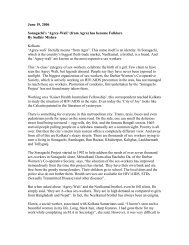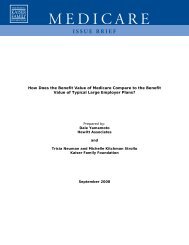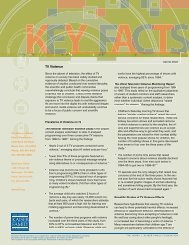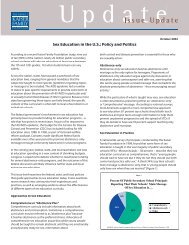HEALTH CARE COSTS: A PRimER - The Henry J. Kaiser Family ...
HEALTH CARE COSTS: A PRimER - The Henry J. Kaiser Family ...
HEALTH CARE COSTS: A PRimER - The Henry J. Kaiser Family ...
You also want an ePaper? Increase the reach of your titles
YUMPU automatically turns print PDFs into web optimized ePapers that Google loves.
Health insurance premium increases consistently outpace inflation and the<br />
growth in workers’ earnings. <strong>The</strong> growth in health insurance premiums is a<br />
straightforward way to measure changes in the cost of private health insurance. As<br />
health care costs increase, it becomes increasingly difficult for families and businesses<br />
to purchase coverage because the price of coverage (the premium) typically increases.<br />
Employers, as purchasers of insurance, may also decide to increase the amount<br />
covered workers must pay to visit the doctor or go to the hospital (the cost sharing),<br />
which can put pressure on family budgets when family members become ill. Figure 15<br />
compares the annual increase in employer premiums to both worker earnings growth<br />
and overall inflation. Premium growth has outpaced the growth in workers’ earnings<br />
almost every year. Whereas premium increases have been between 3 and 13% per<br />
year since 2000, inflation and changes in workers’ earnings are typically in the 2 to 4%<br />
range. This usually means that workers have to spend more of their income each year<br />
on health care to maintain coverage. Again, these effects may either be direct –<br />
through increased worker contributions for premiums or reduced health benefits – or<br />
indirect – such as when employers reduce wages or limit wage increases to offset<br />
increases in premiums. Average annual worker and employer contributions to total<br />
premiums have increased since 1999, with the worker contribution for family coverage<br />
increasing from $1,543 in 1999 to $4,129 in 2011 (Figure 16).<br />
Figure 15: Cumulative Increases in Health Insurance<br />
Premiums, Workers’ Contributions to Premiums, Inflation,<br />
and Workers’ Earnings, 2000-2010<br />
Notes: Health insurance premiums and worker contributions are for family premiums<br />
based on a family of four.<br />
Source: <strong>Kaiser</strong>/HRET Survey of Employer-Sponsored Health Benefits, 1999-2011.<br />
Bureau of Labor Statistics, Consumer Price Index, U.S. City Average of Annual<br />
Inflation (April to April), 1999-2011. Bureau of Labor Statistics, Seasonally Adjusted<br />
Data from the Current Employment Statistics Survey, 1999-2011 (April to April).<br />
18 THE HENRY J. KAISER FAMILY FOUNDATION












